A few weeks ago we took a look at the MSI X38 Diamond, the new X48 is a "clone" of this board without the extra sound card, so it's called "Platinum." Due to the fact, the boards are quite the same, we decided to bench the X48 only, as the benchmark results are the same.
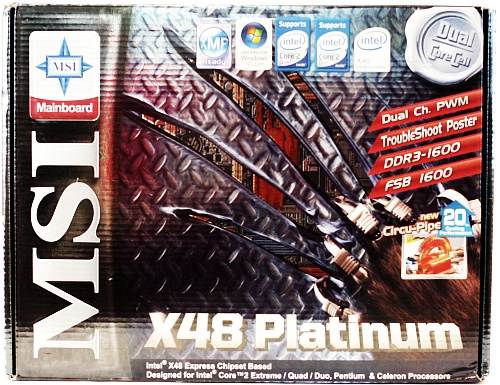
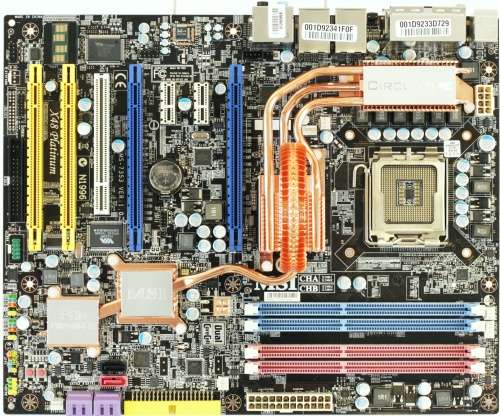
Features:
Intel X48/iCH9R
8-phase VRM
VIA VT6308P
Realtek ALC888
Realtek 8111B PCIe network MAC
Intel 82566 PCIe network PHY
Marvell 88SE6111 SATA II RAID 0,1/IDE controller
Silicon Image SIL5723 SATA II RAID 0,1 controller
Fintec F71882FG Super I/O controller
ICS9LPRS910BKL clock generator
IDT 89HPES16T7ZBH PCIe switch chip
passive cooling of chipsets/VRM
8Mb BIOS, version 2.2
Slots:
2x PCIe 2.0 x16
2x PCIe x16@x4
2x PCIe x1
1x PCI
Memory:
2x Dual-Channel DDR3-slots for PC2-8500U memory up to 8GB
Storage:
4-Port SATA II featuring RAID 0, 1, 5, 0+1, JBOD (via ICH9R)
1-Port IDE (via Marvell)
2-Port SATA II featuring RAID 0, 1 (via Sil)
2-Port eSATA II (via ICH9R)
Backpanel ports:
1x PS/2 keyboard
2x eSATA II
1x Gb LAN
1x Firewire
6x USB 2.0
1x CMOS-clear button
7.1 analog output
1x SP/DIF digital out
1x SP/DIF coaxial out
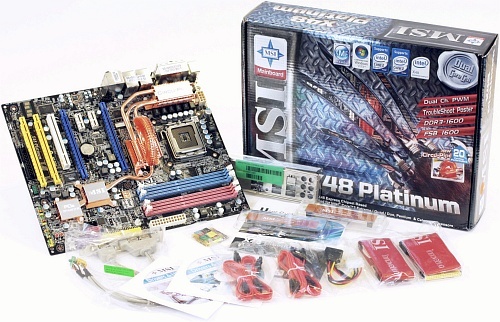
Accessories:
1x 2-port USB 2.0 & 1-port Firewire bracket
6x SATA cable with clips
1x HDD-power to 2x SATA power cable
1x HDD-power to 1x SATA power cable
1x Floppy cable
1x IDE cable
1x MSI M-connector pack
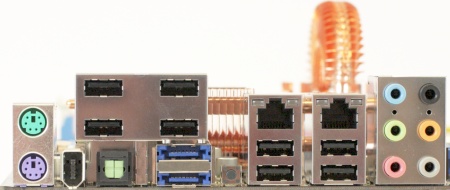
BIOS features:
Bus Speeds: Auto, 200MHz to 800MHz in 1MHz increments
Memory Ratios: Auto, fixed ratios: 1:1, 1:1.2, 1:1.25, 1.50, 1.60, 1.66, 1:2 depending on FSB/strap
FSB Strap: hidden, linked with Memory Ratio, 200MHz, 266MHz, 333MHz, 400MHz
DRAM command rate: Auto, 1T, 2T
DRAM timing control: Auto, manual
PCIe Frequency: Auto, 100 to 200 MHz in 1MHz increments
CPU Clock Multiplier: Auto, manual
Core 2 Duo: 6x-11x in 0.5x increments - Core-2 Duo, downwards unlocked
Core 2 Extreme: 6x-16X, downwards unlocked
CPU Voltage: auto, 1.1500V to 1.9500V in 0.0125V increments
DRAM Voltage: auto, 1.50V to 2.75V in 0.04V increments
FSB Termination: auto, 1.20V to 1.44 in various increments
Northbridge Voltage: auto, 1.25V to 1.83V in various increments
Testbed:
Motherboard:
MSI X48 Platinum (provided by MSI)
Intel X48/iCH9R
CPU:
Intel Core 2 Duo E8400
CPU-Cooler:
Scythe Andy Samurai Master (provided by Scythe-Europe)
Memory:
Patriot 2GB Kit PC3-10666U PDC32G1333LLK (provided by Patriot)
CL7-7-7-20-CR2T @1066MHz 1.50V
Kingston 2GB Kit PC3-14400U KHX14400D3K2/2G (provided by Kingston)
CL7-7-7-20 CR2T @1600MHz+ 1.90V
Graphics Card:
Jetway Radeon HD3870 (provided by mec-electronics)
Power supply:
Seasonic S12-II 500W
Hard disk:
Western Digital WD4000KD (provided by Ditech)
Case fans:
SilenX iXtrema Pro 14dB(A) (provided by PC-Cooling.at)
Scythe DFS122512LS
Case:
Cooler Master Stacker 831 Lite (provided by Cooler Master)
Layout:
MSI did a quite nice job, only specification-wise we have some complaints. The board features the new roller-coaster-Northbridge cooler known from the MSI P35 Platinium, the height has increased which successfully blocks some CPU-coolers, such as the Scythe Zipang.
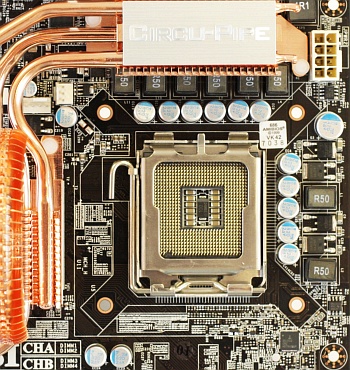
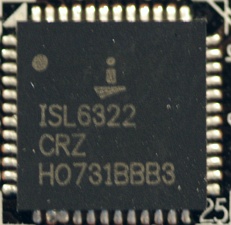
The VRM is an analog dual 4-phase design driven by an ISL6322. Sadly, MSI didn't opt for a digital VRM solution, but they did a quite good job with the power-consumption in previous products. The CPU EPS V12 connector is located on the right edge of the board above the CPU socket. We had hoped for a location below the CPU-socket to avoid some cable-mess with smaller cases, but it will do.
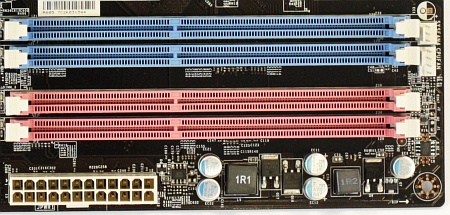
The memory slots are quite close to the primary PCIe x16 slot, so you need to fiddle with your modules when replacing or upgrading them while a large graphics card is installed, but it's manageable. As usual, the 24-pin power connector is located beneath.
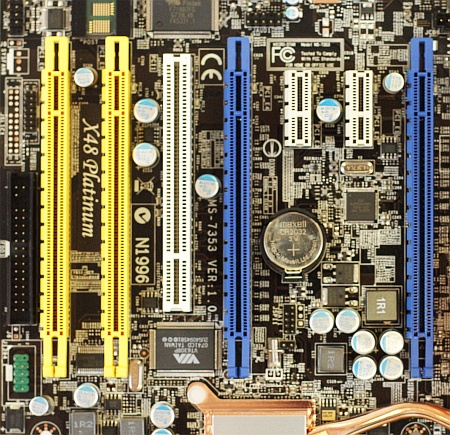
The slots are configured for a quad-crossfire configuration. While "quad-crossfire" may sound "cool," we doubt it's a wise way to go. Three PCIe x16 is the maximum we would recommend and additional PCI slots for older extension cards. The fastest graphics cards come in a two-slot configuration, using two of them, it will render the PCI slot useless. The yellow slots are also only x4 speed, it would have been wiser to have set all slots to x8, because PCIe 2.0 x8 is the same speed as PCIe 1.1 x16. If you own a TV-card or other PCI extension cards, you won't be able to have that and Quad-Crossfire together.
At least the split yellow PCIe x16 slots can be used for other cards beside graphics even though the manual doesn't say anything about it. MSI used an IDT 89HPES16T7ZBH chip to split 8 lanes to 2x 4. Floppy is located on the left edge of the board, which may cause some troubles with big cases.
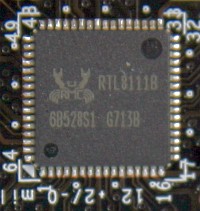
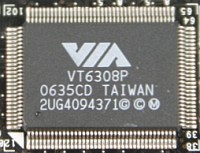
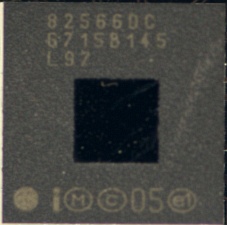
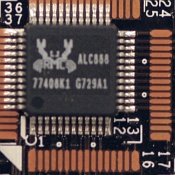
Network connectivity is provided by one Realtek Gb 8111B PCIe chip and one Intel 82566 PHY, wihich is connected to the ICH9R network MAC. VIA VT6308P chip provides two Firewire-slots, one on the back panel, one header on the board. A Realtek ALC888 chip will give you the onboard sound solution.

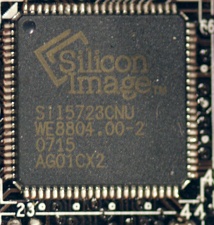
The SATA and PATA connectors are, as usual, on the bottom edge of the board. Four SATA connectors are angled, so a second large graphics card will fit above them. The SATA 7 and 8 ports are standard and will get in the way with a large two-slot graphics-cards. We don't understand why there are two extra controllers on board, because the Marvell 88SE6111 does feature two SATA-ports but they are not used.
We would have wished for all six ICH9R SATA-ports, the Sil or Marvell would have done nicely for eSATA; what a waste and you have to pay for it. Below left of the PCIe switch-chip, you will find two buttons for power-on and reset, the CMOS-clear-button is located on the back-panel.
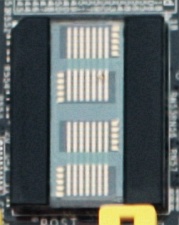

Above the yellow PCIe x16 slots you will find an MSI port-80 post diagnostic display, but not a standard LED design, something special. We don't think this was a good idea, because it costs more money and does not provide detailed information only short words such as "CPU", "DRAM", "VGA" and some more. Right of it you will find the super-I/O-controller which contains controllers for PS/2, floppy and fans.
BIOS:
As usual, an MSI board comes with an AMI BIOS. The hyped "Cell" feature is still much too crude for real overclocking fans. The steppings for the voltages are defined by the BIOS, oc-freaks have no chance to fine tune via BIOS. MSI needs to improve the BIOS especially when the oc-market is targeted. Also some voltage settings are way too high.
1.9250V Vcore is needed for overclocking records with nitrogen-cooling, but for normal users this is quite insane. When the board can't boot up, the BIOS behaves strangely and does change some voltages, especially VCore on its own. We think this is quite dangerous and if someone does overclock, the BIOS should not override any settings.
FSB-Overclocking:
This MSI does very well. Of cours,e we did expect a high overclock. The board booted with 570MHz, the board run stable with 560MHz, very nice.
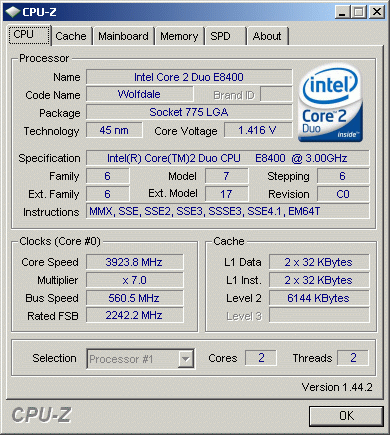
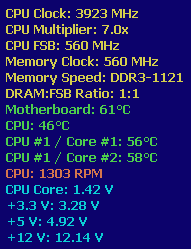
CPU-overclocking:
It was not difficult to reach 4.40GHz. We set the VCore to 1.6000V but as you can see, the VCore dropped to 1.55V. The VRM is quite good to keep the drop below 0.05V.
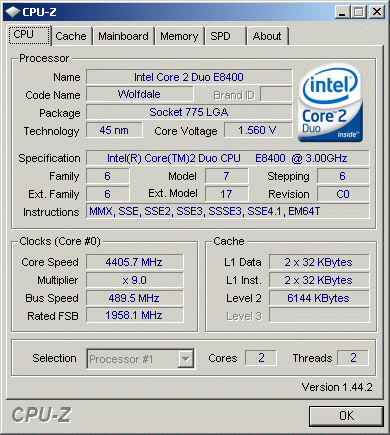
Memory-overclocking:
MSI claims the board runs with DDR3 1600MHz, and indeed it does. Going any higher it gets difficult. With reduced latencies we could manage 1700MHz, but we weren't able to do 1800MHz, which was the specified rating of our Corsair Kit.
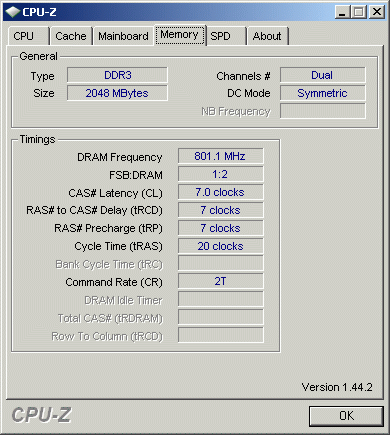
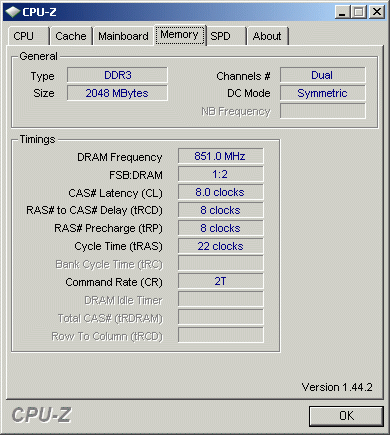
FSB BIOS clocking:
We have to state that we always recalculate the bench results to nominal frequencies. Most vendors do an overclock to their products, maybe to get more bench points, but we nullify such attempts. MSI always overclocks and we don't like that.
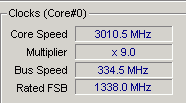
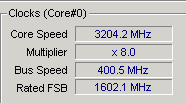
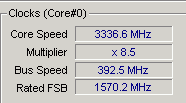
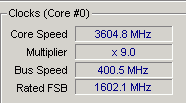
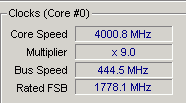
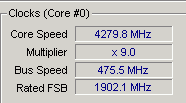
Benchmarks:
Please note that different bios revisions may give different results. All benches are done with AUTO settings without altering any BIOS option besides CPU VCore, NB VCore and FSB Termination Voltage.
x264:
x264 is a h.264/AVC codec which supports four threads, and it's available for free. We took a PAL episode of "Babylon 5" with a length of 41 minutes, 57 seconds and 8 frames. We tried to "emulate" the most common usage when you encode your movies:
1st: We have a perfect master, so we only de-interlace the content and resize it without any other manipulations; we marked this as "fast."
2nd: You get bad mastering on many DVDs, especially "old" stuff or when the studios are in a hurry for the release. In this case you want to improve the picture quality, which is done by filtering the content. You can choose from lots of filters for any purposes you can think of, but we only used the most common "undot," "FluxSmooth" and "MSharpen." Of course, we also de-interlaced, filters were done before any resizing took place (which is slower). We marked this as "slow."
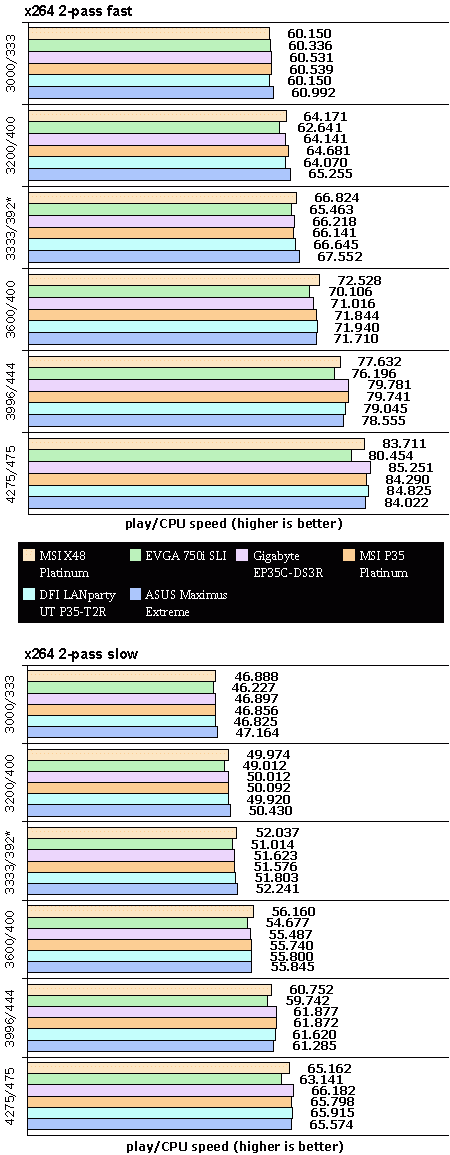
*Note: The DFI P35 mainboard doesn't support half multipliers, so it was using 417x8.
LameMT:
The same episode we encoded, we used for our MP3-testing. We don't recommend using MP3 for encoding, because AC3 can do the job better, but nearly 42 minutes gives us approximately the length of any given album.
A measurement in seconds, as many sites do, is useless, because the differences are too small. So we used the built-in play/CPU ratio, this means the CPU is encoding x-times faster then the track-length. Fast memory does not play an important role here. For your convenience we also show the single-threaded benchmarks figures, they can be re-produced with any version of L.A.M.E. Only LameMT can do multi-thread and take advantage of multi-core processors.
We used this setting: lamemt --vbr-new -q 2 -V 2 -m j --strictly-enforce-ISO --resample 48
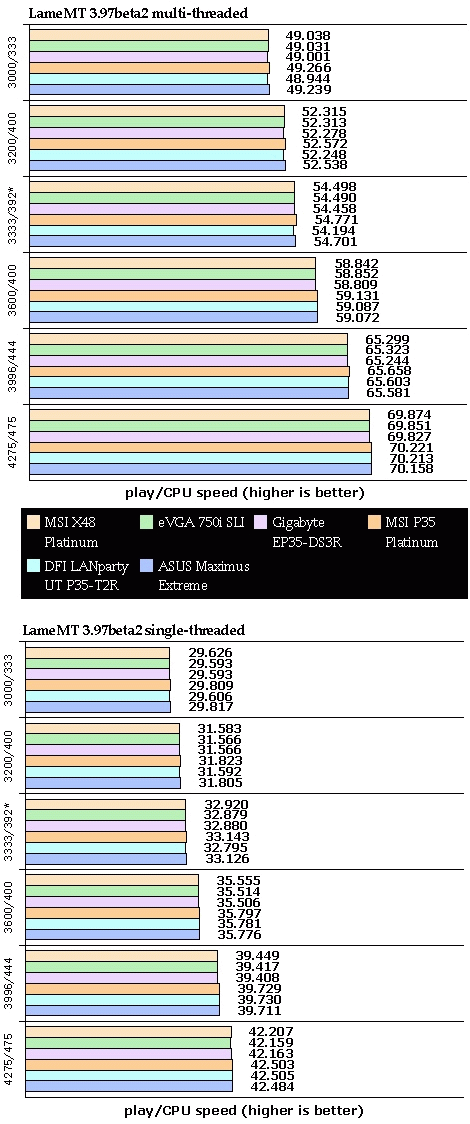
*Note: The DFI P35 mainboard doesn't support half multipliers, so it was using 417x8.
Power-Consumption:
Our standard PSU went dead, so we had to change it and re-test other boards to give you some comparsions. Notice the IDT chip does waste about 10W even when there are no graphic-cards installed. We used as less VCore as possible, so our E8400 works fine with 1.1500V @3GHz.
Please note that other configurations may yield other results.

Conclusion:
We do not think that a Crossfire X board is very appealing for the masses. While you can use the ports for other cards, the IDT chip increases the power-consumption. It's our opinion you are better off with the X48C Combo board without the IDT PCIe switch chip, which does feature DDR2 memory. DDR2 is still cheaper and so is the board, so you may invest a little bit more for a graphics-card and improving the price/performance ratio.
This board does fine, but for real hardcore overclockers the BIOS is much too limited and the voltage steppings are much too crude. Besides that, the board does well and the good sign is MSI high-end boards are getting better.
The board is available for about €190,- the X48C is about €10 cheaper, but it seems currently out of stock. Besides the Intel offering, which is not an "all solid capacitor" design, MSI X48 offerings are the cheapest available, owning either of the boards is a good choice.

